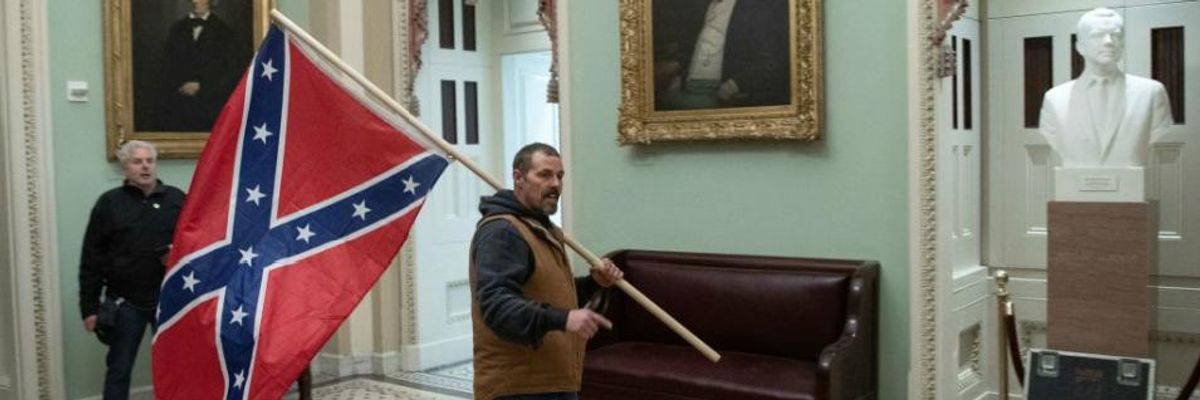Pundits desperately searching for a historical analogy for the storming of the U.S. Capitol have seized on August 1814, when the British army burned the Capitol in retaliation for the U.S. assault on the Canadian capital a year earlier.
But there's a more apt comparison. Fifty years later, in July 1864, with the Civil War still raging, a Confederate army came within shooting distance of capturing Washington. Confederate Gen. Jubal Early could see the shining dome of the Capitol "feebly manned," he later wrote, a mere six miles away.
Though troop fatigue, summer heat, and the late arrival of more Union troops ultimately rebuffed the invasion, it would later become part of the "Lost Cause" mythology of the Confederate cause that lives on in the hearts of white supremacists like those armed insurrectionists who overran, vandalized, and looted the Capitol also with feeble resistance on January 6, leaving several deaths in their wake.
"While the January 6 putsch, like Jubal's army and the Confederate insurgency failed, it too threatens to live on long past the departure of Trump from the White House."
These insurrectionists too carried the banners of the Lost Cause--Confederate battle flags, emblems and regalia, "Civil War" t-shirts, and numerous other symbols of the aligned far right, racist and anti-Semitic vestiges of the past, and present, including lynching nooses, Q-anon conspiracy insignias, and Nazi memorabilia such as a Camp Auschwitz hoodie.
Just as Early's attack was part of a white supremacist campaign to overthrow a democratically elected government, the insurrectionists had a similar goal. That's what clearly made this assault more than a riot. The intent--openly encouraged by President Trump--was to prevent the certification of a democratically elected President in favor of a defeated President with similar aspirations who had long encouraged and coddled them, and other politicians aligned with him.
While the January 6 putsch, like Jubal's army and the Confederate insurgency failed, it too threatens to live on long past the departure of Trump from the White House.
In the early years after the fall of the Confederacy, the most vigilant Congressional advocates of justice, joining with the millions of formerly enslaved people and those who had built a heroic abolition movement, enacted the most transformative, revolutionary reforms in U.S. history.
Those included the first truly democratic multi-racial, Reconstruction governments which implemented sweeping political and social reforms in education, health care, and civil rights that benefited the entire population, and landmark Constitutional amendments codifying abolition of slavery, equal justice under the law, and voting rights for Black men.
But other, more poisonous seeds had been planted too. Northern politicians and financial interests, more committed to "re-union" with the defeated slaveocracy than to racial, social and economic justice, failed to hold the leaders of the rebellion to full account. Ultimately, they stood by and became complicit as emboldened former Confederate soldiers carried out a counter revolution in wave after wave of terrorist assaults on Black leaders, activists and communities, and the new democratic institutions they had created.
The disastrous consequences for democracy, racial justice, and rights for women, workers, and the commons as a whole reverberated for nearly a century until the mass movement of the Civil Rights era begin a new moment of reform and a hope for a more equitable society.
But that vision was never accepted by the adherents of the Lost Cause. They have longed for a return to what labor and racial justice scholar/activist Bill Fletcher Jr. has described as a "white republic" and an obsession with "revanchism," a "particular form of revenge" for what they believe are lost political power and privileges in racial and gender roles, and "they want it back." That is what is behind their mission to "save America" from a "stolen election."
What makes this "Lost Cause" an even more dangerous brew is the presence of heavily armed white supremacist militia, and their infiltration in police agencies and other law enforcement that is a reminder of days in the Jim Crow eras when sheriff's deputies would brutalize civil rights protesters during the day, and then adorn their KKK robes and hoods at night. Though many have noted the disparity between police repression of racial justice protesters and the soft welcome of the insurrectionists at the Capitol, few have fully investigated that dangerous link.
"Though many have noted the disparity between police repression of racial justice protesters and the soft welcome of the insurrectionists at the Capitol, few have fully investigated that dangerous link."
The lesson we must learn from the crushing of Reconstruction is that escorting Trump out the door must not be the end of this story. It is imperative that the leaders and perpetrators of both the insurrection and all the assaults on our democratic institutions that inspired it, must not be allowed to escape justice and accountability.
That extends to the reining in the violent threats and hate crimes of the white supremacist far right, effective real reforms of police lawlessness and racism, and protections of our democratic values and rights, starting with restoration of the Voting Rights Act.
Rather than leap to a new "re-union" with those so dedicated to continuing their fight for the new Lost Cause, it would be worthwhile to recall the words of Frederick Douglass staring at the attacks on Reconstruction in 1871: "We are sometimes asked in the name of patriotism to forget the merits of this fearful struggle, and to remember with equal admiration those who struck at the nation's life, and those who struck to save it--those who fought for slavery and those who fought for liberty and justice."

